 |
 |
|
 |
News conferences kickoff Mn/DOT’s snow, ice safety program |
 |
 |
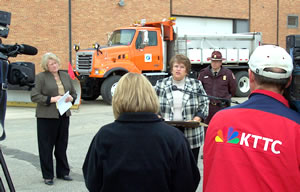 |
|
Rochester/District 6 Engineer Nelrae Succio fields questions from reporters at a news conference in Rochester on Nov. 8 to kick off the department's snow and ice maintenance efforts. Lt. Gov. Carol Molnau, at left, looks on. Photo by Brian Jergenson
|
With just a few snowflakes shy of winter, Mn/DOT staff conducted news conferences in Mendota Heights and Rochester Nov. 8 to encourage safe driving in the winter season and to inform the public about details of the department’s snow removal efforts this year.
Lt. Gov./ Commissioner Carol Molnau carried a message from Gov. Tim Pawlenty.
"We have dedicated, hard-working snowplow operators in Mn/DOT,” Pawlenty said in a news release issued for the event. “As they have in the past, they will do their best to keep the roadways clear and safe. Those of us driving in winter conditions need to be cautious, drive safely and give the snowplow a chance to work.”
Each year, Minnesota records an average of 93 crashes involving snowplows. The crashes result in an average of 16 injuries per year.
“Safe, sensible driving by the state’s motorists remains a key element in our efforts to keep the state’s highways,” Molnau said. “The best thing for motorists to do during a snowstorm is to be patient and give the plows time and room to remove the snow.”
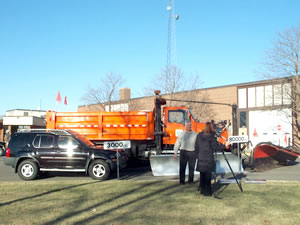 |
As part of a city, county and state snowplow safety exhibit in downtown Mankato on Nov. 12, Mankato/District 7 Operations Engineer Gordan Regenscheid is interviewed by KEYC-TV. The car and snowplow behind Regenscheid are used to illustrate the difference in weight between the two vehicles: an average car weighs about 3,000 pounds while a fully loaded truck weighs 80,000 pounds. Photo by Rebecca Arndt |
With the addition of 100 newly trained operators, Mn/DOT’s 1,600-plus snow fighters will operate more than 790 snowplows and match their well-honed skills, calm reserve and endurance with the dozens of snowstorms they will encounter this winter.
Maintenance supervisors will guide snowplow operators with constant updates on weather, pavement and traffic conditions. Snowplows are equipped with sensors that monitor air and pavement temperatures, and managers are monitoring air and ground moisture levels and wind direction to determine which methods or chemicals will work best under current conditions.
“The technology and roadway information systems enhance our ability to remove snow and ice,” said Bob Winter, director of district operations. “It helps us make the most of our resources and do the work more efficiently and quickly.”
“I also want to thank our legion of snow plow drivers,” Molnau said. “They are a very dedicated, professional group who take their jobs very seriously. They are well-trained and probably have the best equipment in the United States. Many of them have been plowing snow for years. They will do whatever it takes to clear our roads. I want to thank them ahead of time for the work they will do for all of us this winter.”
|
back

|
 |
New features provide more oomph, flexibility for latest generation of snowplows |
 |
 |
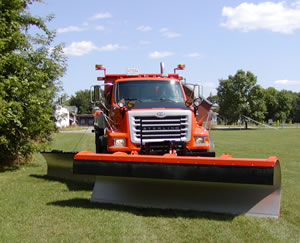 |
|
This recently outfitted tandem-axle snowplow will roll through a lot of whiteness before it rides on green grass again next spring. Photo by Randy Cameron
|
As they roll out of the Central Shop, Mn/DOT’s freshly minted snowplow trucks include new highly visible—and useful—standard features.
You can tell them by their stainless steel boxes and spreaders, saddle-mounted de-icing chemical tanks and improved joystick controllers that make operating the huge rigs a bit easier for plow drivers.
One feature remains unchanged, though: the plows are still the familiar Mn/DOT blaze-orange color.
The new equipment will be included on both the single-axle (Class 33) and tandem-axle (Class 35) snowplow trucks. The crew at the Central Shop facility at Fort Snelling outfits about 60 of the basic Sterling truck chassis per year to create a fully ready-to-roll snowplow.
The new plows are making a significant impact on Mn/DOT’s snowplow fleet. About 60 vehicles in the fleet are the latest version of the standard plow. More will join them.
Randy Cameron, Central Shop supervisor, said the brand new trucks and their upgraded capacity will make a significant contribution to keeping the state’s roads clear of ice and snow during this and future winters.
Mn/DOT’s plows, he added, now all have same Dickie-John brand controllers for applying sand and salt which makes it easier for operators to move from plow to plow when needed. Having standardized controllers also makes it a lot easier for mechanics to service the trucks as well, he said.
The stainless steel truck boxes are oval-shaped to keep the sand/salt mixture from collecting in the corners. Using stainless steel helps the boxes and spreaders resist the effects of rust, a common ailment of snowplow trucks.
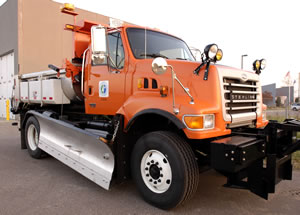 |
Mounting the de-icing chemical tanks near the truck's center of gravity instead of attached at the rear improves weight distribution, handling and braking. Photo by David Gonzalez |
Cameron said mounting the de-icing chemical tanks near the trucks' center of gravity instead of attached at the rear improves weight distribution, handling and braking.
The new controllers, he said, simplify operations by placing switches and levers for several functions on one joystick that’s easy to handle for snowplow operators.
Further standardization will occur next year, he said, when both the single-axle and tandem-axle plows will be equipped with Caterpillar diesel engines. Currently, the Class 33 single-axle trucks are powered by Cummins diesels.
By Craig Wilkins
|
back

|
 |
Molnau expresses appreciation for past work, hope for future |
 |
 |
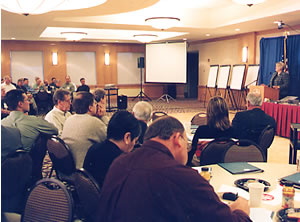 |
|
Mn/DOT managers listen to Lt. Gov./ Commissioner Carol Molnau as she opens the fall Managers’ Conference held Nov. 10 at the Shoreview Community Center. Photo by Craig Wilkins |
Using new technology—a speech carried live departmentwide on the intranet—Lt. Gov./ Commissioner Carol Molnau assessed her first two years as commissioner and shared her appreciation for the accomplishments made by Mn/DOT employees.
Her remarks were made during the fall Managers’ Conference held Nov. 10 at the Shoreview Community Center.
The managers’ agenda also included a review of transportation financing proposals put forth by advocacy groups, managing in times marked by uncertainty and a preview of the 2005 session of the Minnesota Legislature.
Molnau looked back on the first two years of her and Gov. Tim Pawlenty’s administration, and then ahead to two major challenges—winter and the next session of the Legislature.
She thanked construction workers, contractors and staff for their efforts to keep the state’s largest construction season on track, the 2004 program valued at nearly $1 billion that includes almost 200 projects.
“We completed projects that range from new lanes on rural roads to adding new lanes on the busy I-94/I-694 corridor in the Twin Cities metro area’s north suburban region.
“I think we are doing remarkably well,” she said.
“While we might focus on the most recently completed projects, we can also feel proud of projects now under way that will be done soon, such as the rebuilding Hwy 52 in Rochester, the Wakota Bridge project in the Twin Cities metro area and Hwy 23 between Willmar and New London,” she said.
“We’re getting better at completing more projects and getting them done faster, but we can’t stop. We need to explore new efforts such as global information system applications, cost management and projects that emerge from the statewide ‘Driving Towards Excellence’ program,” she said.
Turning her focus to winter, Molnau said Mn/DOT remains committed to use its resources to keep roads safe for motorists this winter.
“Mn/DOT’s top priority is providing safe and reliable travel for motorists, no matter what the season,” she said. “I want to assure you and the public that we will do everything we can to keep the roads safe this winter.”
Molnau also saluted Mn/DOT’s corps of snowplow operators for their skill and dedication.
“They will do whatever it takes to clear our roads,” she said.
Addressing the next legislative session, Molnau said Mn/DOT will continue its efforts to secure a long-term, stable transportation funding source that will enable the department to reach its goals.
“Mn/DOT is well-positioned to work through the budget process,” she said. “We are fortunate to have existing programs such as our systems of targets and measures to help the department work better.”
Molnau told the conference participants and employees watching statewide that she appreciates the work done by all Mn/DOT people.
“I’m excited and honored to join with Mn/DOT employees and our state partners to move forward and improve the state’s transportation system,” she said.
By Craig Wilkins
Streaming video tested at Mn/DOT
On Wednesday morning, Nov. 10, Lt. Gov./Commissioner Carol Molnau was in Shoreview and I was at my desk in the Central Office. But at 8 a.m., I turned on my computer and there she was, talking to me live from the Mn/DOT Managers’ Conference through streaming video.
“Streaming video works just like TV,” according to Bob Bennett, Office of Information Technology. “A video camera captured the lieutenant governor as she spoke at the Manager’s Conference and fed it into a computer. This recording was then distributed via the Mn/DOT network to computers statewide.”
Because not all employees are able to view streaming videos on their personal computers, the address also was broadcast live in all videoconference rooms.
“A small percentage of computers do not have streaming video capability at this time, but enough do to make the technology beneficial,” Bennett said.
Streaming video technology is not new, but it is the first time Mn/DOT has used the technology to transmit important, timely information to all employees.
“There are many potential future uses for streaming video,” Bennett said. “It can help connect employees with a leaders or transmit technical information that is difficult to understand without a demonstration.”
For the most part, Mn/DOT employees were positive about their experience seeing the lieutenant governor on streaming video.
- “Mine worked wonderfully...I even enjoyed it!!!”
- “The video was too small.”
- “It was great. It sure could be useful in saving trips around the state.”
- “The video froze for a couple of seconds, but the audio continued.”
- “I would like to see this available for other occasions.”
- “Thanks everyone in the IT office for all your hard work over the past month to make this possible!”
Play it again, Sam!
You can see and hear a rebroadcast of the lieutenant governor’s address at a computer within Mn/DOT on Thursday, Nov. 18, at 11 a.m. An appointment notifying employees of the rebroadcast was sent on Wednesday afternoon. Check with your supervisor for permission to view the 30-minute broadcast.
To view the rebroadcast, go to http://oitvideo/dotlivestream from any location on the Web. If you encounter technical difficulties, please share a computer with another employee rather than calling your local IT staff for technical support. This rebroadcast will not be provided in Mn/DOT videoconference rooms.
By Donna Lindberg
|
|
back

|
 |
Tentative agreements on design, location promise hope for building new St. Croix River bridge crossing |
 |
 |
 |
|
An artist’s rendering of how the new Stillwater Bridge will look when it spans the St. Croix River between Oak Park Heights and Wisconsin Hwy 64 near Houlton, Wisc. |
The oft-debated, long-awaited St. Croix River crossing moved closer to becoming a reality on Oct. 27 when conferees from Mn/DOT, WisDOT, the FHWA, interest groups and regulatory agencies agreed on a location for a new river crossing.
The bridge would carry Hwy 36 across the St. Croix River at Oak Park Heights to connect with Wisconsin ’s Hwy 64 near Houlton. The proposed project also includes approach work in both Minnesota and Wisconsin.
The route chosen is the southernmost route among the three corridor alternatives. The bridge would be constructed just south of Stillwater in Oak Park Heights.
The conferees, known as the Stakeholder Resolution Group, also concurred that the bridge should use an “ extradosed” configuration as its preferred design.
According to the FHWA, the extradosed design is a hybrid combination of a cable-stayed bridge and a box-girder structure. The design allows cable towers about half the height of an equivalent cable-stayed bridge, an important consideration for the structure’s visual impact on the St. Croix River Valley .
When built, the St. Croix River crossing will be only the third such bridge constructed in the United States.
The unique design allows builders to use concrete beams about 500 feet in length and to reduce the number of bridge piers by half compared with the previously proposed box-girder structure. Reducing the number of piers meets requirements by the regulatory agencies to minimize the impact of the bridge on the scenic river valley. The bridge would be about one mile in length from its connection with Hwy 36 to Hwy 64 in Wisconsin .
Part of the agreement also includes keeping the existing Stillwater Bridge; the historic lift bridge would become part of a bike/pedestrian trail between the two states. The new bridge, 1.25 miles south of the existing structure, will also have pedestrian and bicycle lanes.
After the agreements are formalized, environmental studies completed and funding secured, work on the project could begin as early as 2007.
The new four-lane bridge will reduce congestion and safety issues in downtown Stillwater and ease the daily commute for people living in Wisconsin’s St. Croix County and other fast-growing areas.
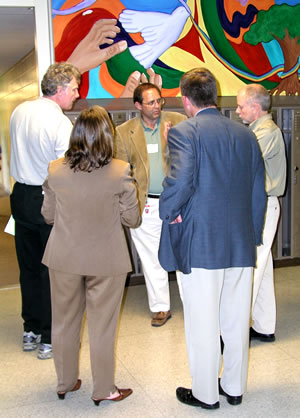 |
Rick Arnebeck, a Metro District regional manager, responds to questions during a public meeting to review options for a new St. Croix River bridge. Photo by Mary S. McFarland |
An executive order from President George W. Bush in 2002 directed the Minnesota and Wisconsin transportation departments and the FHWA to find a workable solution for the project. The group members received full access to the environmental review process, bridge design proposals and other data.
The agreement ends an ongoing dispute by government and private interests over the bridge’s location, design and impact on development of the region and future use of the lift bridge.
“There are issues that remain to be resolved including funding commitments, the routing of Hwy 36 in Oak Park Heights and approvals from the states and the FHWA,” said Lt. Gov. Carol Molnau.
“Mn/DOT is committed to provide a safe transportation solution in an increasingly congested area. We’re optimistic that we can resolve the outstanding issues by putting our personal objections aside to achieve consensus and a long-lasting benefit for region.”
Rick Arnebeck, Metro District area manager for Washington and Chisago counties, said the preliminary agreement will help resolve issues that remain.
“Our next step is to work out details and conditions and start developing a funding strategy for the project,” he said.
Remaining issues include the route of Hwy 36 in Oak Park Heights where the bridge’s approaches will be built, completion of the final environmental impact statement and design of the recreational trail that will use the old Stillwater lift bridge.
“We have a lot of work left to do,” Arnebeck said, “but we’re all excited that the project earned tentative approval and that we can continue working to get it done.”
More information can be found on the project’s Web site at: http://www.dot.state.mn.us/metro/projects/stcroix/.
By Craig Wilkins
|
back

|
 |
Cancer claims life of Darryl E. Durgin, former deputy commissioner |
 |
 |
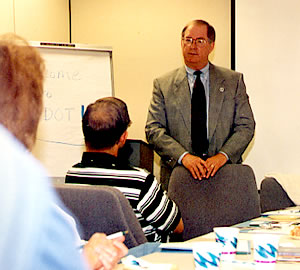 |
|
Darryl E. Durgin, a former Mn/DOT deputy commissioner/chief engineer who died Nov. 4, welcomed a group of teachers participating in an aviation education program in 1999. Durgin retired that year, ending his 40-year career in public service. Photo by Craig Wilkins |
Friends, neighbors and former colleagues gathered Nov. 9 in Nisswa to mourn the passing of Darryl E. Durgin, a former Mn/DOT deputy commissioner/chief engineer who died Nov. 4.
Durgin was 68. He died of complications from leukemia.
After retiring from Mn/DOT in 1999, Durgin lived in East Gull Lake, Minn.
Durgin was appointed as deputy commissioner in 1991. Until his retirement, he served with former commissioners Len Levine, the late John Riley, James Denn and Elwyn Tinklenberg.
Durgin’s career with the department started in 1957 when he was an undergraduate trainee in the Thief River Falls Construction Office. He graduated from the University of North Dakota with a bachelor’s degree in civil engineering in 1959 and joined Mn/DOT as a graduate engineer.
He held several technical and managerial posts with Mn/DOT before his appointment as deputy commissioner, including district engineer at Brainerd from 1974 until 1983. He also served as the Kittson County engineer from 1967 until 1969.
In addition to his contributions to Mn/DOT, Durgin served on Hiway Federal Credit Union’s board of directors for more than three decades. He served as the board’s chair from 1979 to 1981.
Durgin’s survivors include his spouse, Charlene Durgin, four children, three brothers and six grandchildren.
While mourning his loss, those present celebrated Durgin’s life and his many contributions to the department, his years of dedicated public service and the personal qualities that marked his 40-year tenure with the agency.
“Darryl became my mentor, confidante and friend,” said Denn, who was appointed commissioner by former Gov. Arne Carlson in 1991.
“He was ethical and principled and not reluctant to put difficult issues on the table and find ways to resolve them,” Denn said. “He developed the talent at hand to make sure we had the expertise to solve problems and get things done right.”
Denn said he added “chief engineer” to Durgin’s title to mark his leadership role in a technically oriented agency.
Denn greatly respected Durgin’s warm and caring nature as well as his technical and managerial skills.
“Darryl was generous, had a good heart and a dry sense of humor; he was fun to be around.” Denn said.
Denn visited Durgin about two weeks before his death at his home in East Gull Lake and delivered the eulogy at his funeral service.
“Darryl was a decent man who treated his family and friends with obvious affection,” he said. “I always knew I had his trust and confidence.”
|
back

|
 |
New laws affecting transportation at your fingertips |
 |
 |
A summary of new and amended state laws that may affect Mn/DOT is available on iHUB.
The summary provides brief descriptions of 34 new laws with links to more information, including the full text of the law and the effective date.
“Of particular importance to Mn/DOT is a section of the transportation housekeeping bill that permits Mn/DOT to lease rest areas or portions of rest areas for tourism and travel-related activities,” said Erik Rudeen, Government Affairs.
This law allows Mn/DOT to deposit any revenue from leasing rest areas into the dedicated safety rest area account.
The summary can be viewed at http://ihub.dot.state.mn.us/information/legislative2004/index.html.
|
back

|
 |
|
 |



